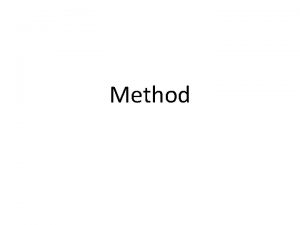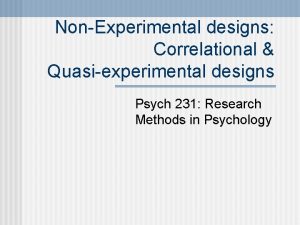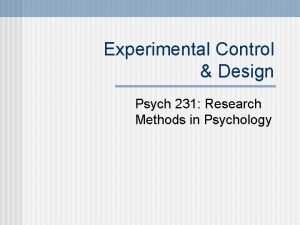Experimental Design Single factor designs Psych 231 Research




















- Slides: 20

Experimental Design: Single factor designs Psych 231: Research Methods in Psychology

Announcements n Reminder: your group project experiment method section is due in labs this week

Experimental designs n So far we’ve covered a lot of the details of experiments, now let’s consider some specific experimental designs. – 1 Factor, two levels – 1 Factor, multi-levels – Factorial (more than 1 factor) • (next Monday’s lecture) – Between & within factors • (this Wednesday’s lecture)

Single variable – One Factor designs n 1 Factor, two levels – Basically you want to compare two treatments (conditions) – The statistics are pretty easy, a t-test Observed difference btwn conditions T-test = Difference expected by chance

1 factor - 2 levels n Example – How does anxiety level affect test performance? • Two groups take the same test – Grp 1 (moderate anxiety group): 5 min lecture on the importance of good grades for success – Grp 2 (low anxiety group): 5 min lecture on how good grades don’t matter, just trying is good enough

1 factor - 2 levels Random Assignment Anxiety Dependent Variable Low Test Moderate Test participants

Single variable – one Factor anxiety low moderate 60 80 test performance One factor low Two levels moderate anxiety

Single variable – one Factor n Advantages: – Is the independent variable worth studying? • If no effect, then usually don’t bother with a more complex design – Sometimes two levels is all you need • One theory predicts one pattern and another predicts a different pattern

Single variable – one Factor n Disadvantages: – “True” shape of the function is hard to see • interpolation and extrapolation are not a good idea

Interpolation test performance What happens within of the ranges that you test? low moderate anxiety

Extrapolation test performance What happens outside of the ranges that you test? low moderate anxiety high

1 Factor - multilevel experiments For more complex theories you will typically need more complex designs (more than two levels of one IV) n 1 factor - more than two levels n – Basically you want to compare more than two conditions – The statistics are a little more difficult, an ANOVA (analysis of variance)

1 Factor - multilevel experiments n Example (same as before with one more group) – How does anxiety level affect test performance? • Three groups take the same test – Grp 1 (moderate anxiety group): 5 min lecture on the importance of good grades for success – Grp 2 (low anxiety group): 5 min lecture on how good grades don’t matter, just trying is good enough – Grp 3 (high anxiety group): 5 min lecture on how the students must pass this test to pass the course

1 factor - 3 levels Random Assignment participants Anxiety Dependent Variable Low Test Moderate Test High Test

anxiety low mod high 60 80 60 test performance 1 Factor - multilevel experiments low mod anxiety high

1 Factor - multilevel experiments n Advantages – Gives a better picture of the relationship (function) – Generally, the more levels you have, the less you have to worry about your range of the independent variable

Relationship between Anxiety and Performance 2 levels test performance 3 levels low moderate anxiety low mod anxiety high

1 Factor - multilevel experiments n Disadvantages – Needs more resources (participants and/or stimuli) – Requires more complex statistical analysis (analysis of variance and pair-wise comparisons)

Pair-wise comparisons The ANOVA just tells you that not all of the groups are equal. n If this is your conclusion (you get a “significant ANOVA”) then you should do further tests to see where the differences are n – High vs. Low – High vs. Moderate – Low vs. Moderate

Next time Adding a wrinkle: between-groups versus within-groups factors n Read chapter 11 n
 Single factor design
Single factor design Quasi-experimental research designs
Quasi-experimental research designs Quasi-experimental research designs
Quasi-experimental research designs Disadvantages of experimental research
Disadvantages of experimental research Experimental vs non experimental
Experimental vs non experimental Experimental design principles
Experimental design principles Matched pair design vs block design
Matched pair design vs block design Research design meaning
Research design meaning Basic principles of experimental designs
Basic principles of experimental designs Research paradigm example
Research paradigm example Research instrument in experimental research
Research instrument in experimental research Experimental vs non experimental
Experimental vs non experimental Solomon four group design
Solomon four group design Nonexperimental study
Nonexperimental study Solomon four group design
Solomon four group design Non experimental research design
Non experimental research design Quasi experiment advantages and disadvantages
Quasi experiment advantages and disadvantages Non-experimental/ descriptive design
Non-experimental/ descriptive design Quasi experimental design notation
Quasi experimental design notation Quasi experimental study
Quasi experimental study Characteristics of experimental research design
Characteristics of experimental research design





































